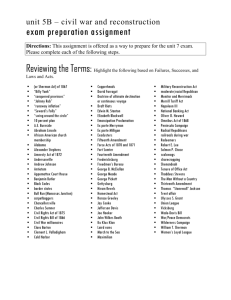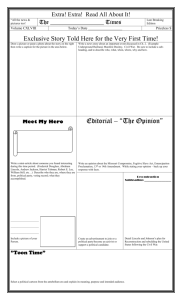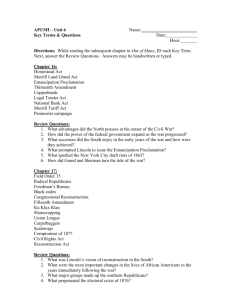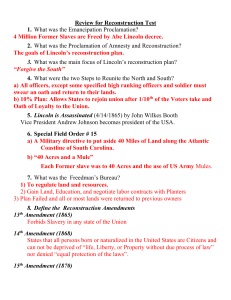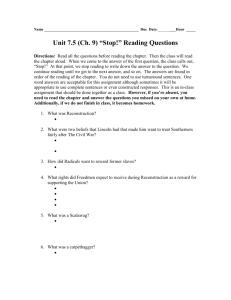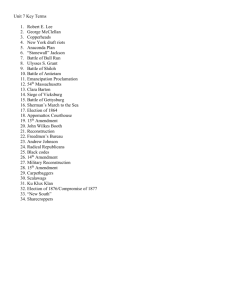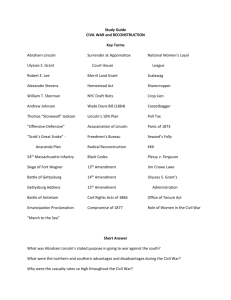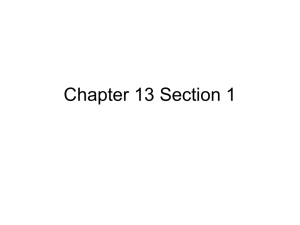08TAVMT Chapter 03
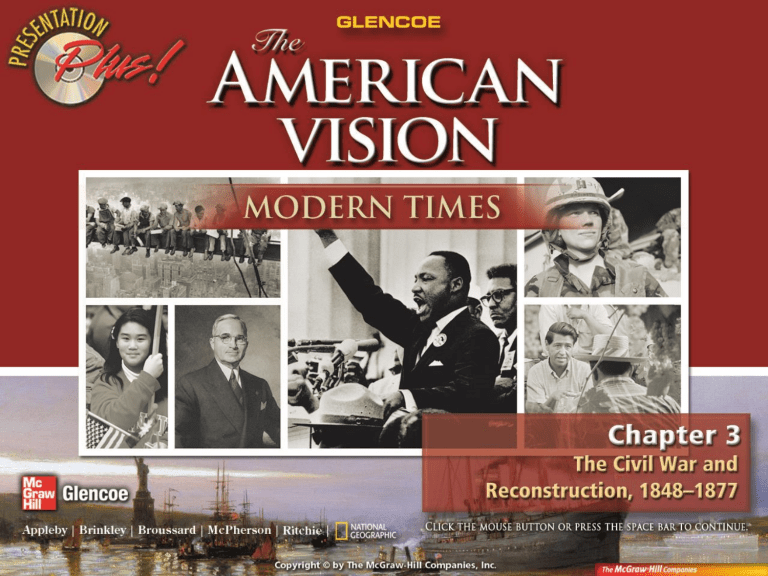
Splash Screen
The Civil War Begins
Fighting the Civil War
Reconstruction
Chapter Menu
How Do Nations Fight and
Recover From War?
The Civil War was in many respects the first modern war. Both sides fielded large armies, and hundreds of thousands of soldiers were killed.
Following the war, the nation faced major problems. American leaders had to find a way to reconcile
Northerners and Southerners, restore
Southern governments, and protect the rights of the formerly enslaved.
• Why was the North able to defeat the south?
• What did the United States do to reconstruct the South?
Chapter Intro
Chapter Timeline
Chapter Timeline
The Civil War Begins
What advantages and disadvantages did the
North and the South have at the start of the
Civil War?
Chapter Intro 1
Fighting the Civil War
How did the Emancipation
Proclamation change the
Civil War?
Chapter Intro 2
Reconstruction
What key issues caused disagreements about how
Reconstruction should take place?
Chapter Intro 3
Chapter Preview-End
Big Ideas
Struggles for Rights After Lincoln’s election to the presidency, many Southerners placed state loyalty above loyalty to the Union.
Section 1-Main Idea
Content Vocabulary
• martial law
• habeas corpus
• attrition
Academic Vocabulary
• sufficient
• implement
Section 1-Key Terms
People and Events to Identify
• Crittenden’s Compromise
• Jefferson Davis
• Confederacy
• Fort Sumter
• Robert E. Lee
• Anaconda Plan
Section 1-Key Terms
Do you agree that the government should be able to limit civil liberties during times of war?
A.
Agree
B.
Disagree
A
0%
A. A
B. B
0%
B
Section 1-Polling Question
The Union Dissolves
The election of Abraham Lincoln led the Southern states to secede from the Union.
Section 1
The Union Dissolves
(cont.)
• Northern and Southern Democrats split over the issue of slavery.
– The Northern Democrats chose Stephen
Douglas as their candidate in 1860.
– The Southern Democrats chose John C.
Breckinridge.
The Election of 1860
Section 1
The Union Dissolves
(cont.)
• The Constitutional Union Party chose
John Bell.
• The Republicans chose Abraham Lincoln.
• Lincoln was elected, and many Southerners viewed this as a threat to their society and culture, even their lives.
• By 1861 seven Southern states had seceded.
Steps to Civil War, 1846 –1860
Section 1
The Union Dissolves
(cont.)
• In December 1860, John J. Crittenden proposed a series of amendments to the
Constitution, known as Crittenden’s
Compromise .
• Congressional Republicans voted against it at Lincoln’s request.
Steps to Civil War, 1846 –1860
Section 1
The Union Dissolves
(cont.)
• On February 8, 1861, delegates from the seceding states declared themselves the
Confederate States of America.
• They drafted a Confederate Constitution.
• Jefferson Davis was the chosen as president and called for the remaining
Southern states to join the Confederacy .
Section 1
The Union Dissolves
(cont.)
• In April of 1861 Lincoln announced that he intended to resupply Fort Sumter , one of the few federal military bases that Southerners had not already seized.
• Jefferson demanded that Fort Sumter surrender before the supply ship arrived.
• The fort’s commander refused, and the Civil
War began.
Section 1
The Union Dissolves
(cont.)
• Between April 17 and June 8, 1861, four more states left the Union.
• To prevent Maryland’s secession, Lincoln imposed martial law in Baltimore, where angry mobs had already attacked federal troops.
Section 1
The following were slaveholding border states that President Lincoln needed to keep in the Union EXCEPT
A.
Kentucky
B.
Missouri
C.
Georgia
D.
Maryland
A
0%
A. A
B. B
C. C
0% 0% 0%
D
Section 1
The Opposing Sides
The North and South each had distinct advantages and disadvantages at the beginning of the Civil War.
Section 1
The Opposing Sides
(cont.)
• Although Robert E. Lee opposed slavery, he still offered his services to the Confederacy.
• Seven of the nation’s eight military colleges were in the South, providing a large number of trained officers.
• Although the South had many experienced officers to lead its troops in battle, the North had several economic advantages.
Section 1
The Opposing Sides
(cont.)
• Advantages of the North during the Civil War:
– a strong naval tradition
– over double the population of the South
– 90% of the nation’s factories were in the North.
– The South had only half as many miles of railroad track as the North.
The Opposing Sides
Section 1
The Opposing Sides
(cont.)
– The South had only one railroad line connecting the western states of the
Confederacy to the east.
– The Union controlled the national treasury.
– Many Northern banks held large reserves of cash , which they lent the government by purchasing bonds.
The Opposing Sides
Section 1
The Opposing Sides
(cont.)
• The Confederacy’s financial situation was poor, and it became worse over time.
• The South experienced 9,000 percent inflation, compared to only 80 percent in the North.
Section 1
The Opposing Sides
(cont.)
• Two factions developed within the
Democratic Party —the War Democrats and the Peace Democrats.
• One major disagreement between
Republicans and Democrats concerned conscription —or forcing people through a draft into military service.
• Criticism also greeted President Lincoln’s decision to suspend writs of habeas corpus .
Section 1
The Opposing Sides
(cont.)
• To pressure the British and French into supporting their cause, many Southern planters agreed to stop selling their cotton in these markets until the Europeans recognized the Confederacy.
• Both countries still decided not to go to war against the U.S.
• The North and South embarked on the first modern war.
Section 1
The Opposing Sides
(cont.)
• There are several reasons the Civil War is considered modern:
– use of huge armies consisting mostly of civilian volunteers
– use of vast amounts of supplies
– use of the conoidal bullet
– use of trenches and barricades to protect the troops
Section 1
The Opposing Sides
(cont.)
• These aspects resulted in much higher casualties.
• Attrition played a critical role as the war dragged on.
Section 1
The Opposing Sides
(cont.)
• Although Jefferson Davis planned on fighting a defensive war of attrition, he felt great pressure to strike for a quick victory.
• The South suffered 20,000 more casualties than the Union by charging enemy lines.
• The general in chief of the United States,
Winfield Scott, suggested what they called the Anaconda Plan .
Section 1
The Opposing Sides
(cont.)
• Many Northerners rejected it because they thought it was too slow and indirect for certain victory.
• Lincoln eventually agreed to implement
Scott’s plan.
Section 1
The Legal Tender Act allowed which of the following?
A.
Creation of a national currency
B.
The issue of paper money
C.
The sale of bonds
D.
A and B
E.
B and C
A. A
B. B
C. C
D. D
0% 0% 0% 0% 0%
C D E
Section 1
Section 1-End
Big Ideas
Individual Action In the final year of the war, Grant refused to let up the pressure the Union forces were putting on Lee’s weary troops.
Section 2-Main Idea
Content Vocabulary
• blockade runner
• siege
• mandate
Academic Vocabulary
• crucial
• guarantee
Section 2-Key Terms
People and Events to Identify
• “Stonewall” Jackson
• Ulysses S. Grant
• Battle of Antietam
• Emancipation Proclamation
• Gettysburg
• William Tecumseh Sherman
• Thirteenth Amendment
Section 2-Key Terms
Was the Civil War necessary in order to end slavery?
A.
Yes
B.
No
A
0%
A. A
B. B
0%
B
Section 2-Polling Question
The Early Stages
With Union casualties rising, President
Lincoln issued the Emancipation
Proclamation.
Section 2
The Early Stages
(cont.)
• Thomas J. “Stonewall” Jackson helped the Confederates defeat the Union forces at the Battle of Bull Run.
• This defeat made it clear that the North would need a large, well-trained army.
The Early Years of the Civil War, 1861 –1863
Section 2
The Early Stages
(cont.)
• While the Union and Confederacy mobilized their armies, President Lincoln proclaimed a blockade of all Confederate ports in an effort to cut Confederate trade with the world.
• However, Union vessels found it difficult to stop all the blockade runners .
The Early Years of the Civil War, 1861 –1863
Section 2
The Early Stages
(cont.)
• Union general Ulysses S. Grant seized all of Kentucky and most of western Tennessee for the Union.
• He also won the Battle of Shiloh, seizing
Corinth, Mississippi.
• In late June 1862, Confederate General
Robert E. Lee began a series of attacks on
McClellan’s forces that became known as the Seven Days’ Battle.
The Early Years of the Civil War, 1861 –1863
Section 2
The Early Stages
(cont.)
• The Battle of Antietam was a crucial victory for the Union for the following reasons:
– The South lost its chance at gaining international recognition and support.
– The North’s victory convinced Abraham
Lincoln that the time had come to end slavery.
Section 2
The Early Stages
(cont.)
• On September 22, 1862, Lincoln publicly announced that he would issue the
Emancipation Proclamation .
• While the South’s economy had begun to suffer greatly, the North’s economy experienced an economic boom.
• Both Union and Confederate soldiers endured a hard life with few comforts.
Section 2
The Early Stages
(cont.)
• While the war brought hardship to many
Americans, the Emancipation Proclamation offered new opportunities for African
Americans.
• Women helped in the war effort at home by managing family farms and businesses.
• The most important contribution of women was serving as nurses to the wounded.
Section 2
The bloodiest one-day battle in American history was which of the following?
A.
The Battle of Bull Run
B.
The Battle of Antietam
C.
The Battle of Shiloh
D.
The Battle of Gettysburg
A. A
B. B
A
0%
B
D. D
0%
D
Section 2
The Turning Point
Key victories at Vicksburg and
Gettysburg helped the North defeat the South.
Section 2
The Turning Point
(cont.)
• Three major Union victories in 1863 put the
Confederacy on the defensive and set the stage for its surrender:
– the victory at Vicksburg
• Grant put the city under siege until its defenders gave up.
– the victory at Gettysburg
– the victory at Chattanooga
The Battle of Gettysburg
Section 2
The Turning Point
(cont.)
• Lincoln rewarded Grant by appointing him general in chief of the Union forces and promoting him to lieutenant general.
• Grant kept his forces on the move and gave
Lee’s troops no time to recover.
The Cost of the Civil War
Section 2
The Turning Point
(cont.)
• General Grant put William Tecumseh
Sherman in charge of Union operations in the west.
• On November 15, 1864, Sherman led his troops east across Georgia in what became known as the March to the Sea.
The Cost of the Civil War
Section 2
The Turning Point
(cont.)
• Lincoln interpreted his reelection as a mandate to end slavery permanently by amending the Constitution.
• On January 31, 1865, the Thirteenth
Amendment was sent to the states for ratification.
• With his ragged and battered troops surrounded and outnumbered, Lee surrendered to Grant on
April 9, 1865.
The Cost of the Civil War
Section 2
The Turning Point
(cont.)
• With the war over, Lincoln delivered a speech describing his plan to restore the
Southern states to the Union.
• However, on the evening of April 14, 1865,
John Wilkes Booth assassinated Lincoln.
Section 2
After General Lee’s surrender,
General Grant decided to prosecute
Confederate soldiers for treason.
A.
True
B.
False
A. A
B. B
A
0% 0%
B
Section 2
Section 2-End
Big Ideas
Economics and Society After Reconstruction, the
South tried to build a new economy, but many problems remained.
Section 3-Main Idea
Content Vocabulary
• amnesty
• pocket veto
• black codes
• carpetbagger
• scalawag
• sharecropper
Academic Vocabulary
• commissioner • infrastructure
Section 3-Key Terms
People and Events to Identify
• Reconstruction
• Radical Republicans
• Freedmen’s Bureau
• Fourteenth Amendment
• Fifteenth Amendment
• Compromise of 1877
Section 3-Key Terms
Would the South have benefited if
Reconstruction had continued?
A.
Yes
B.
No
A
0%
A. A
B. B
0%
B
Section 3-Polling Question
Reconstruction Begins
In the months after the Civil War, the nation began the effort to rebuild and reunite.
Section 3
Reconstruction Begins
(cont.)
• After the Civil War, the president and
Congress grappled with the difficult task of
Reconstruction .
• In December 1863, President Lincoln set forth his moderate plan for reuniting the country in the Proclamation of Amnesty and
Reconstruction.
Section 3
Reconstruction Begins
(cont.)
• He offered a general amnesty to all
Southerners who took an oath of loyalty to the United States and accepted the Union’s proclamations concerning slavery.
• Resistance to Lincoln’s plan surfaced at once among a group of Republicans in
Congress known as Radical Republicans .
Section 3
Reconstruction Begins
(cont.)
• Radical Republicans wanted to achieve the following:
– Prevent the leaders of the Confederacy from returning to power after the war.
– Make the Republican Party a powerful institution in the South.
– Make the federal government help African
Americans achieve political equality by guaranteeing their right to vote in the
South.
Section 3
Reconstruction Begins
(cont.)
• By the summer of 1864, the moderates and radicals had come up with a plan for
Reconstruction that they could both support, known as the Wade-Davis Bill.
• Lincoln blocked it with a pocket veto , fearing that imposing a harsh peace would only alienate many whites in the South.
Section 3
Reconstruction Begins
(cont.)
• In March 1856, Congress established the
Bureau of Refugees, Freedmen, and
Abandoned Lands, better known as the
Freedmen’s Bureau .
• After Lincoln’s assassination, Andrew
Johnson became president.
• He remained loyal to Lincoln’s moderate policy to bring the South back to the Union.
Section 3
Reconstruction Begins
(cont.)
• However, many members of Congress were astonished and angered when they realized that Southern voters had elected dozens of
Confederate leaders to Congress.
• Congressional Republicans were also angry that the new Southern legislatures had passed laws known as black codes .
Section 3
Reconstruction Begins
(cont.)
• In March, congressional Reconstruction began with the passage of the Civil Rights
Act of 1866.
• Fearing that the Civil Rights Act might later be overturned in court, the radicals introduced the Fourteenth Amendment to the Constitution.
Section 3
Reconstruction Begins
(cont.)
• After the Republicans won approximately a three-to-one majority in Congress, they began to enact their own Reconstruction program in place of Johnson’s.
• In March 1867, Congress passed the Military
Reconstruction Act, which essentially nullified Johnson’s programs.
Military Reconstruction, 1867
Section 3
Reconstruction Begins
(cont.)
• In the meantime, each former Confederate state had to hold another constitutional convention to design a constitution acceptable to Congress.
• To restrict Johnson’s power further,
Congress passed two new laws: the
Command of the Army Act and the Tenure of
Office Act.
Section 3
Reconstruction Begins
(cont.)
• After Johnson challenged the Tenure of
Office Act, the House of Representatives voted to impeach Johnson.
• He was one vote short of conviction, and finished his term quietly.
Section 3
Reconstruction Begins
(cont.)
• Republican Ulysses S. Grant won the 1868 election.
• Congressional Republicans moved rapidly to expand their Reconstruction program.
• Congress passed the Fifteenth
Amendment .
Section 3
Which amendment states that all people born or naturalized in the United States are citizens?
A.
The Thirteenth Amendment
B.
The Fourteenth Amendment
C.
The Fifteenth Amendment
A. A
B. B
0%
A B C
Section 3
Republican Rule
As African Americans entered politics, some white Southerners began to resist Republican reforms.
Section 3
Republican Rule
(cont.)
• Southerners, particularly supporters of the
Democratic Party, called the Northerners who traveled to the South carpetbaggers .
• Some white Southerners did work with
Republicans and supported Reconstruction.
– The other Southerners called them scalawags .
Section 3
Republican Rule
(cont.)
• Having gained the right to vote, African
American men entered into politics with great enthusiasm.
– They served as legislators and administrators for nearly all levels of government.
• The Republican governments in the South instituted a number of reforms that included:
– repealing the black codes
Section 3
Republican Rule
(cont.)
– establishing state hospitals and institutions for orphans
– rebuilding roads, railways, and bridges damaged during the Civil War
– providing funds for construction of new railroads and industries in the South
Section 3
Republican Rule
(cont.)
• Unable to strike openly at the Republicans running their states, some Southern opponents of Reconstruction organized secret societies to undermine Republican rule.
– The largest of these groups was the Ku
Klux Klan.
– Congress passed three Enforcement Acts in 1870 and 1871, one of which outlawed the activities of the Klan.
Section 3
Which of the following people would NOT be considered a scalawag?
A.
Former Whigs who had grudgingly joined the
Democratic Party before the war
B.
Owners of small farms who did not want wealthy planters to regain power
A. A
C.
Democrats who were not in 0%
B. B
0% favor of Reconstruction plans
A B
C. C
C
D.
Business people who favored Republican economic plans
D. D
0%
D
Section 3
Reconstruction Ends
Reconstruction ended as Democrats regained power in the South and in
Congress.
Section 3
Reconstruction Ends
(cont.)
• Eventually, Grant’s lack of political experience helped to divide the Republican
Party and to undermine public support for
Reconstruction.
• During Grant’s second term, a series of scandals damaged his reputation.
– In addition, the nation endured a staggering and long-lasting economic crisis.
Section 3
Reconstruction Ends
(cont.)
• In the 1870s, Democrats began to regain power in the South.
• They did so in the following ways:
– intimidation and fraud
– defining elections as a struggle between whites and African Americans
– promising to cut the high taxes the
Republicans had imposed
– accusing Republicans of corruption
Section 3
Reconstruction Ends
(cont.)
• In 1876 the presidential election pitted
Republican Rutherford B. Hayes against
Democrat Samuel Tilden.
– On Election Day, twenty electoral votes were disputed.
– Congressional leaders worked out a deal known as the Compromise of 1877 .
– Hayes then took office.
Section 3
Reconstruction Ends
(cont.)
• Many Southern leaders called for the creation of a “New South”—believing the region needed a strong industrial economy.
– Some parts of the South did witness great economic changes, while other parts remained agrarian and changed only a little.
• The collapse of Reconstruction ended
African American hopes of being granted their own land in the South.
Section 3
Reconstruction Ends
(cont.)
– Many worked for wages or became sharecroppers .
• The Civil War had ended slavery, but
Reconstruction had left many African
Americans trapped in poverty.
Section 3
The Compromise of 1877 required
Republicans to do which of the following?
A.
Reinstate slavery.
B.
Pull federal troops out of the South.
C.
Provide farming supplies to poor Southern farmers.
0%
A. A
B. B
0%
A
D.
Help the South pay its war debts.
D. D
0%
C
0%
D
Section 3
Section 3-End
North v. South
1861
• Lincoln orders a blockade of Southern ports.
• The Confederacy organizes its government.
• The South wins the First Battle of Bull Run.
• Both sides begin building up their forces.
VS 1
North v. South
1862
• Farragut captures New Orleans.
• After the Battles of Shiloh and Murfreesboro, the Union gains control of western Tennessee.
• Led by McClellan, Union troops land in Virginia to begin the Peninsular Campaign; after a series of battles with Lee’s forces,
McClellan’s forces withdraw.
• Lee invades the North, but is defeated at the Battle of Antietam.
VS 2
North v. South
1863: The Turning Point
• Lincoln issues the
Emancipation Proclamation.
• Grant captures Vicksburg after a long siege and cuts the
Confederacy in two.
• After winning the battles of Fredericksburg and
Chancellorsville, Lee invades the north but is defeated at the Battle of Gettysburg.
• After losing the Battle of Chickamauga, Union forces drive back Southern forces at the Battle of Chattanooga.
• Grant is given command of all Union forces.
VS 3
North v. South
1864
• Grant battles Lee’s forces in northern Virginia; Lee retreats into Petersburg, which Grant puts under siege.
• Sherman captures Atlanta, then begins his March to the Sea across Georgia.
VS 4
North v. South
1865
• Lee attempts to escape from
Petersburg but is surrounded by Grant’s forces and surrenders at Appomattox
Courthouse; other
Confederate forces surrender as well.
• Lincoln is assassinated.
VS 5
VS-End
Figure 1
Figure 2
Figure 2a
Figure 3
Figure 4
Figure 5
Figure 6
Figure 7
Figure 8
Chapter Transparencies Menu
Select a transparency to view.
Chapter Trans Menu
Why It Matters Trans
C & E Trans
Unit Timelines Trans
DFS Trans 1
ANSWER: Union troops
DFS Trans 2
DFS Trans 3
martial law
the law administered by military forces that is invoked by a government in an emergency
Vocab1
habeas corpus
a legal order for an inquiry to determine whether a person has been lawfully imprisoned
Vocab2
attrition
the act of wearing down by constant harassment or attack
Vocab3
sufficient
enough, adequate
Vocab4
implement
to put into action
Vocab5
blockade runner
ship that runs through a blockade, usually to smuggle goods through to a protected area
Vocab6
siege
a military blockade of a city or fortified place to force it to surrender
Vocab7
mandate
authorization to act given to a representative
Vocab8
crucial
something considered important or essential
Vocab9
guarantee
a statement of assurance
Vocab10
amnesty
the act of granting a pardon to a large group of people
Vocab11
pocket veto
indirectly vetoing a bill by letting a session of congress expire without signing the bill
Vocab12
black codes
laws passed in the South just after the Civil War aimed at controlling freedmen and enabling plantation owners to exploit African American workers
Vocab13
carpetbagger
name given to many Northerners who moved to the South after the Civil
War and supported the Republicans
Vocab14
scalawag
name given to Southerners who supported Republican Reconstruction of the South
Vocab15
sharecropper
farmer who works land for an owner who provides equipment and seed and receives a share of the crop
Vocab16
commissioner
the officer in charge of a department or bureau of the public service
Vocab17
infrastructure
the basic, underlying framework or features of a system or organization
Vocab18
To use this Presentation Plus! product:
Click the Forward button to go to the next slide.
Click the Previous button to return to the previous slide.
Click the Home button to return to the Chapter Menu.
Click the Transparency button from the Chapter Menu, Chapter Introduction, or
Visual Summary slides to access the transparencies that are relevant to this chapter. From within a section, click on this button to access the relevant Daily
Focus Skills Transparency.
Click the Return button in a feature to return to the main presentation.
Click the History Online button to access online textbook features.
Click the Reference Atlas button to access the Interactive Reference Atlas.
Click the Exit button or press the Escape key [Esc] to end the chapter slide show.
Click the Help button to access this screen.
Links to Presentation Plus! features such as Maps in Motion, Graphs in Motion,
Charts in Motion, Concepts in Motion, and figures from your textbook are located at the bottom of relevant screens.
Help
This slide is intentionally blank.
End of Custom Shows
